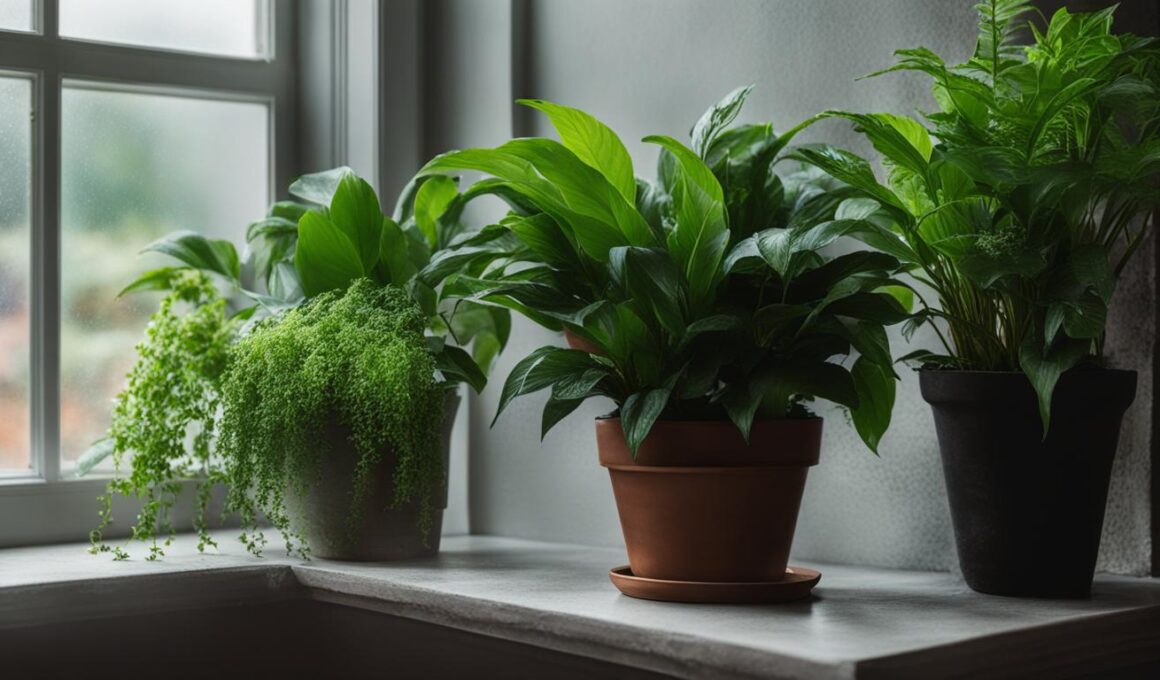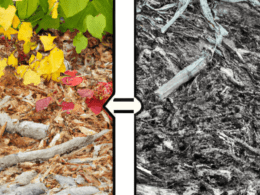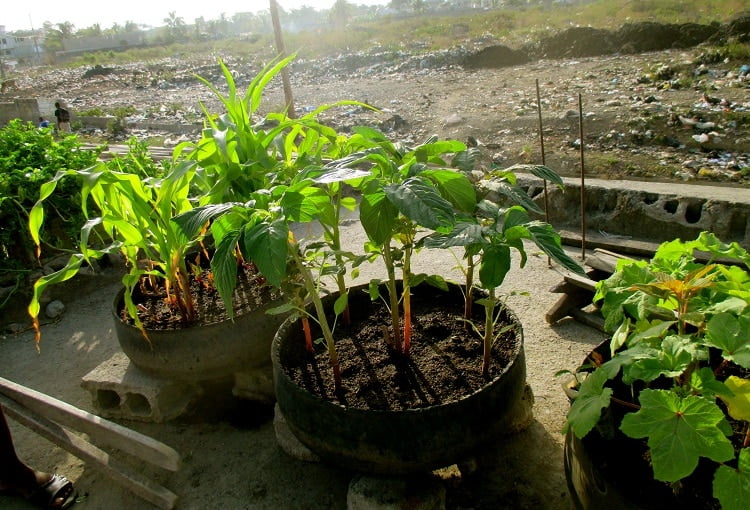Indoor plants have become a popular addition to many homes, bringing a touch of nature and beauty indoors. However, there are concerns about the potential for mold growth on walls due to the presence of these plants. In this article, we will explore whether indoor plants can cause mold on walls and provide insights into preventing and removing mold in your home.
Post Summary:- Indoor plants do not directly cause mold to grow on walls.
- Mold on walls is typically caused by high humidity, poor ventilation, and water damage.
- Indoor plants may contribute to increased moisture levels, but proper care and maintenance can help prevent mold growth.
- To remove mold from indoor plant soil, scrape off the top layer and apply an antifungal treatment.
- Preventing mold on walls involves controlling moisture levels, addressing leaks, and practicing proper ventilation.
How to Remove Mold from Indoor Plant Soil
If you’ve noticed mold growing on your indoor plant soil, there are steps you can take to effectively remove it. By following these tips, you can maintain a healthy and mold-free environment for your plants.
1. Scrape off the Mold
Start by using a spoon or a small trowel to carefully scrape off the top layer of soil where the mold is present. Be sure to remove as much of the mold as possible without disturbing the roots of the plant.
2. Apply Antifungal Treatment
Once you’ve removed the mold, it’s important to prevent it from regrowing. Apply an antifungal powder or spray over the top layer of soil. This will help inhibit the growth of mold and protect your plants from future infestations. Remember to reapply the treatment as needed.
3. Adjust Watering Frequency
Overwatering can contribute to mold growth in plant soil. To prevent mold from developing quickly, reduce the frequency of watering your plants. Allow the soil to dry out between waterings to discourage the growth of mold and other fungi.
4. Improve Air Circulation
Poor air circulation can create a humid environment that is conducive to mold growth. To minimize moisture buildup, make sure your indoor plants are placed in well-ventilated areas. This will help prevent the conditions that promote mold development.
By following these steps, you can effectively remove mold from your indoor plant soil and create a healthier environment for your plants. Regular monitoring and proper plant care are essential in preventing mold growth and maintaining the well-being of your indoor greenery.
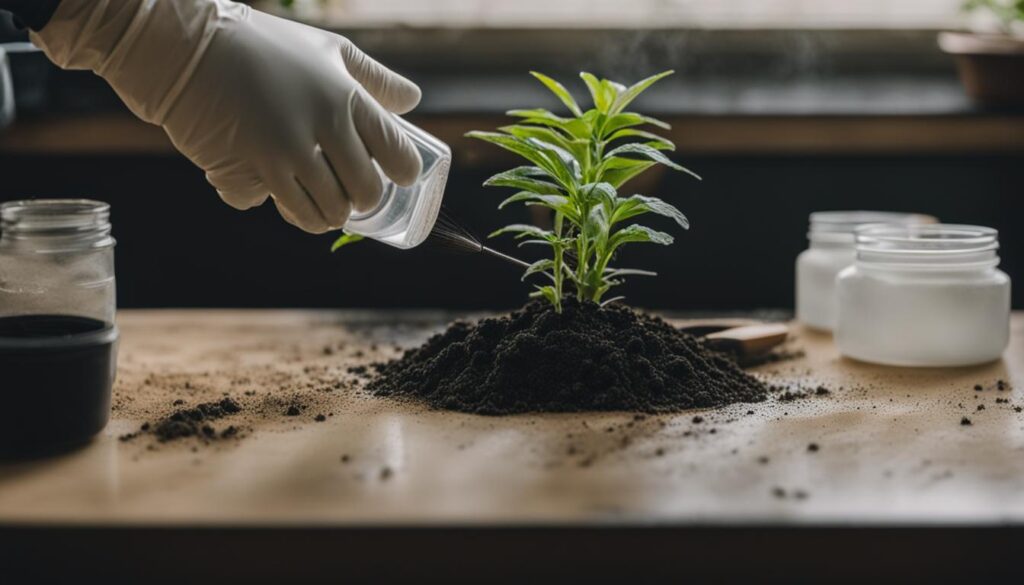
What Causes Mold on Walls?
Mold on walls can be caused by several factors, including high levels of humidity, poor ventilation, and leaks or flooding in the home. Excess humidity combined with inadequate airflow provides an ideal environment for mold growth. Leaks and water damage in areas such as basements, walls, or roofs can lead to mold growth if left untreated. It is important to address these issues promptly to prevent mold from spreading and causing health problems.
Common Causes of Mold on Walls
- High humidity: When the air in your home has excessive moisture, it can create the perfect conditions for mold to thrive. This can be due to activities such as cooking, showering, or drying clothes indoors.
- Poor ventilation: Insufficient airflow can trap moisture indoors, making it difficult for the excess moisture to escape. This can happen in poorly ventilated bathrooms, kitchens, or basements.
- Leaks and water damage: Any form of water intrusion, whether it’s from a leaky roof, plumbing issue, or flooding, can provide the moisture needed for mold to grow.
These factors often work together, creating a synergistic effect that promotes mold growth. For example, a leaky pipe combined with high humidity and inadequate ventilation can quickly lead to mold on walls.
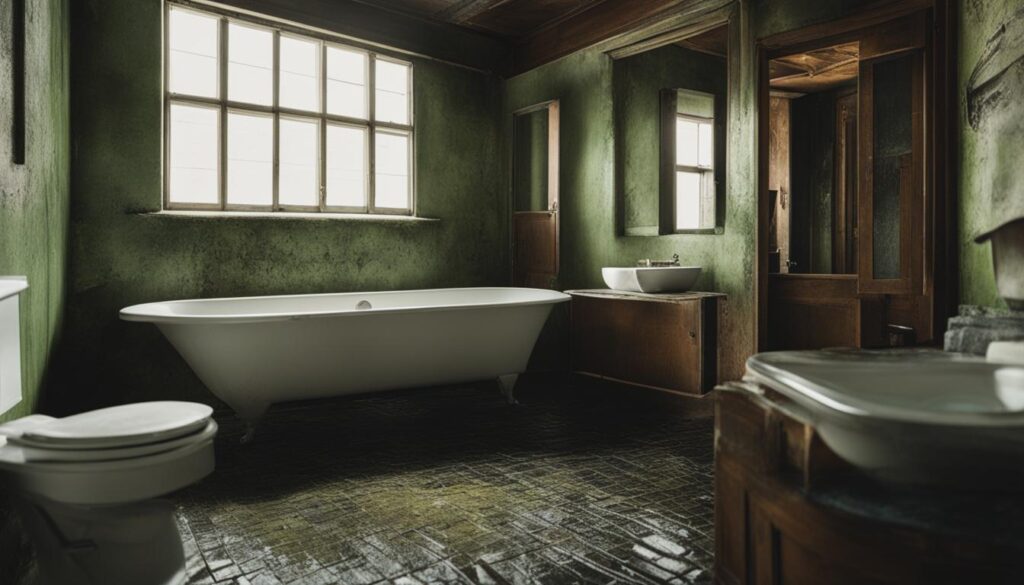
The image above illustrates the common causes of mold on walls. It visually represents the interaction between high humidity, poor ventilation, and water damage in promoting mold growth. Understanding these causes is essential for effectively preventing and addressing mold issues in your home.
Addressing the Causes
To prevent mold on walls, it is crucial to address the underlying causes:
- Monitor humidity levels: Use a hygrometer to measure the humidity in your home. Ideally, it should be below 50%. If it’s higher, consider using dehumidifiers or increasing ventilation to reduce moisture.
- Improve ventilation: Ensure that your home is adequately ventilated in areas prone to moisture, such as bathrooms and kitchens. Install exhaust fans or open windows to enhance airflow and reduce humidity.
- Repair leaks promptly: Inspect your home regularly for any signs of leaks, such as water stains or dampness. Fix any leaks as soon as possible to prevent water damage and mold growth.
By addressing these causes and implementing preventive measures, you can effectively reduce the risk of mold on your walls and create a healthier living environment for you and your family.
| Cause | Effects |
|---|---|
| High humidity | Promotes mold growth |
| Poor ventilation | Traps moisture indoors |
| Leaks and water damage | Provides moisture for mold growth |
The table above summarizes the causes and effects of mold on walls. It highlights the relationship between each cause and its impact on mold growth. Understanding these connections is essential for effectively preventing and addressing mold issues in your home.
Preventing Mold from Growing on Walls
Preventing mold growth on walls requires proactive measures to control excess moisture, maintain proper humidity levels, improve ventilation, and strategically place indoor plants. By implementing these strategies, you can create an environment that is less favorable for mold growth and minimize the risk of mold damage to your home.
Controlling Excess Moisture
Excess moisture is a key factor in mold growth. To prevent mold from growing on walls, it is important to address any sources of moisture in your home. Repair any leaks in your plumbing or roof promptly, and ensure that water drains away from your home’s foundation. Additionally, using a dehumidifier can help control humidity levels and reduce moisture in the air.
Improving Ventilation
Poor ventilation can contribute to the buildup of moisture in your home, creating an ideal environment for mold growth. To improve ventilation, open windows and use fans to increase airflow. You can also install exhaust fans in areas prone to moisture, such as bathrooms and kitchens. Proper ventilation helps remove excess moisture and prevents it from accumulating on walls.
Strategic Placement of Indoor Plants
While indoor plants can contribute to increased humidity levels, strategic placement can minimize the risk of mold growth. Avoid placing plants directly against walls, as this can trap moisture and create a breeding ground for mold. Instead, place plants in well-ventilated areas and consider using saucers or trays to catch excess water. Regularly monitor your plants for signs of mold and remove any dead leaves or organic material that can promote mold growth. By taking these precautions, you can enjoy the benefits of indoor plants without compromising your home’s mold prevention efforts.
| Prevention Strategies | Description |
|---|---|
| Control Excess Moisture | Repair leaks, ensure proper drainage, and use a dehumidifier to reduce moisture levels. |
| Improve Ventilation | Open windows, use fans, and install exhaust fans in moisture-prone areas. |
| Strategic Plant Placement | Avoid placing plants against walls, monitor for mold, and remove dead leaves or organic material. |
By following these preventive measures, you can create an environment that discourages mold growth on walls. Remember to regularly inspect your home for any signs of mold and take immediate action if mold is detected. Mold prevention is an ongoing process that requires diligence and attention to detail, but the effort is well worth it to protect your home and the health of your family.
Using Indoor Plants to Prevent Mold
While indoor plants may contribute to increased humidity levels, they can also be used strategically to help prevent mold growth in your home. Proper placement, watering techniques, and regular plant care can all play a role in minimizing the risk of mold. Here are some tips to effectively use indoor plants as a mold prevention strategy:
Strategic Placement
Place indoor plants in areas of your home that are prone to mold growth, such as bathrooms and kitchens. These areas often have higher humidity levels, and plants can help absorb excess moisture from the air. Be sure to choose plants that thrive in those environments, such as peace lilies or ferns, which are known for their mold-fighting properties.
Proper Watering
Water your indoor plants appropriately to prevent overwatering and excess moisture. Allow the soil to dry out between waterings, as constantly damp soil can create the perfect conditions for mold growth. Be mindful of not only the frequency but also the amount of water your plants receive. Avoid letting water accumulate in the plant saucer or pot, as it can lead to stagnant water and increased humidity.
Dead Leaves Removal
Regularly remove dead leaves and branches from your indoor plants. Dead plant matter can provide a breeding ground for mold spores, so keeping your plants tidy and free of debris is essential. Trim off any decaying leaves or stems to avoid creating a damp environment that promotes mold growth.
Dehumidifier
Consider using a dehumidifier in your home to reduce overall humidity levels. This can help create an environment that is less favorable for mold growth. A dehumidifier can effectively remove excess moisture from the air, complementing the mold prevention efforts of your indoor plants.
| Indoor Plant | Mold-Fighting Properties |
|---|---|
| Peace Lily | Absorbs moisture and purifies the air |
| Ferns | Thrives in humid environments and helps regulate moisture |
| Spider Plant | Filters the air and reduces mold spores |
| Rubber Plant | Improves air quality and resists mold growth |
By strategically using indoor plants and following these tips, you can create a healthier and mold-resistant environment in your home. Remember to choose plants that are suitable for the specific conditions of each area, water them properly, keep them tidy, and consider using a dehumidifier to maintain optimal humidity levels. These simple steps can go a long way in preventing mold growth and promoting a cleaner and more enjoyable living space.
Can Houseplants Cause Mold On Carpet?
Houseplants and carpet damage can be a real concern. When watering houseplants, excess moisture can seep into carpets, creating a damp environment perfect for mold growth. To prevent this, use a waterproof tray under your plant pots and avoid overwatering. Regularly check for dampness or discoloration on the carpet to catch any potential mold issues early on.
Conclusion
In conclusion, indoor plants do not directly cause mold to grow on walls inside your home. Mold growth on walls is primarily caused by high humidity, poor ventilation, and water damage. While indoor plants can contribute to increased moisture levels in the air, proper mold prevention involves controlling moisture levels in the home, addressing leaks promptly, and ensuring adequate ventilation.
Using indoor plants strategically and practicing proper plant care can help reduce the risk of mold growth. Placing plants in areas prone to mold growth, such as bathrooms and kitchens, can absorb excess moisture. Proper watering techniques, allowing the soil to dry out between waterings, can minimize moisture levels that promote mold growth. Regularly removing dead leaves and branches also reduces the likelihood of mold growth.
Additionally, incorporating a dehumidifier in your home can help reduce overall humidity levels and prevent mold on walls. Regular home maintenance, including monitoring for mold growth and addressing any issues promptly, is essential in preventing mold in your home. By following these mold prevention measures and maintaining a healthy indoor environment, you can enjoy the benefits of indoor plants without the worry of mold growth.
FAQ
Can indoor plants cause mold on walls?
While indoor plants can contribute to increased humidity levels in the air, they do not directly cause mold to grow on walls. Mold growth on walls is primarily caused by high humidity, poor ventilation, and water damage.
How can I remove mold from indoor plant soil?
To remove mold from indoor plant soil, you can use a spoon to scrape off the top layer of soil where the mold is present. It is also recommended to use an antifungal powder or spray over the top layer of soil to prevent mold regrowth. Reapply the antifungal treatment as needed. Additionally, reducing the frequency of watering your plants can help prevent mold from developing quickly.
What causes mold on walls?
Mold on walls is typically caused by high levels of humidity, poor ventilation, and leaks or flooding in the home. Excess humidity combined with inadequate airflow provides an ideal environment for mold growth. Leaks and water damage in areas such as basements, walls, or roofs can lead to mold growth if left untreated.
How can I prevent mold from growing on walls?
To prevent mold from growing on walls, it is important to control excess moisture. This can be achieved by maintaining proper humidity levels in your home through the use of dehumidifiers, opening windows, and utilizing fans. Repairing any leaks in your roof or plumbing and ensuring proper ventilation can also help prevent mold growth. Placing indoor plants in well-ventilated areas and away from walls can minimize moisture buildup. Regularly monitoring for mold growth and taking immediate action to address any issues is essential in preventing mold on walls.
Can indoor plants be used to prevent mold?
Yes, indoor plants can help prevent mold when used strategically. Placing plants in areas prone to mold growth, such as bathrooms and kitchens, can absorb excess moisture. Ensuring that plants receive enough natural light and watering them appropriately, allowing the soil to dry out between waterings, can minimize moisture levels that promote mold growth. Removing dead leaves and branches regularly also reduces the likelihood of mold growth. Additionally, using a dehumidifier in your home can help reduce overall humidity levels and prevent mold on walls.
How can I prevent mold in my home?
Mold prevention in your home includes controlling moisture levels, addressing leaks and water damage promptly, ensuring adequate ventilation, using indoor plants strategically, and practicing proper plant care. Regular home maintenance and vigilance are key in preventing mold in your home.





